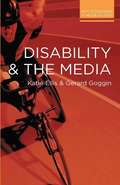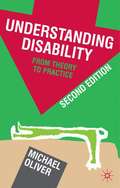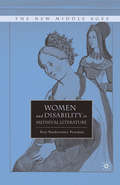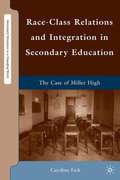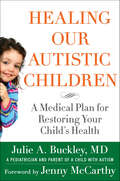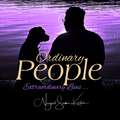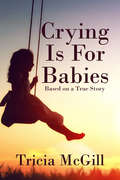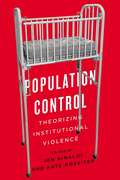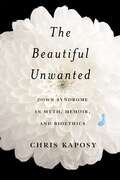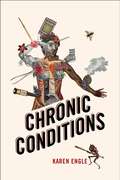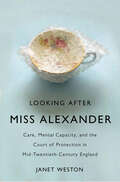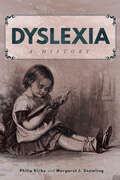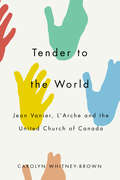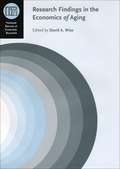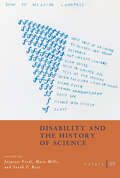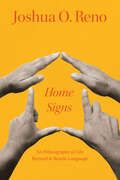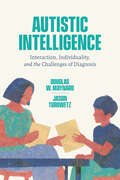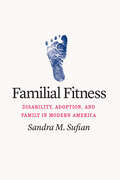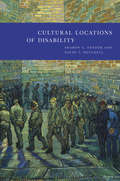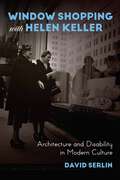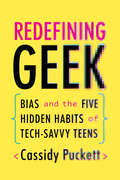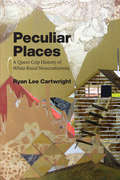- Table View
- List View
Disability And The Media
by Katie Ellis Gerard GogginThis concise, integrated introduction to the complex relationship between disability and the media offers a roadmap to the key areas of participation, access and representation. Bringing together international theoretical work and research on disability, with analysis and examples across a diverse range of media forms – from radio, to news, popular television and new digital technologies – this unique text explores the potential for establishing a more diverse, rich and just media. Providing an approachable but critical introduction to the field, Katie Ellis and Gerard Goggin show how disability – like the closely connected areas of race and gender – is a pervasive issue in how the media represent society.
Understanding Disability: From Theory To Practice
by Michael OliverIn this long awaited new edition Oliver draws on his own experiences to paint a vivid picture of both the practical challenges of disablement and the theoretical understandings of disability. This approachable text is core reading for social work, nursing, health and social care and social science students taking modules in disability studies.
Women and Disability in Medieval Literature
by Tory Vandeventer PearmanThis book is first in its field to analyze how disability and gender both thematically and formally operate within late medieval popular literature. Reading romance, conduct manuals, and spiritual autobiography, it proposes a 'gendered model' for exploring the processes by which differences like gender and disability get coded as deviant.
Race-Class Relations and Integration in Secondary Education
by Caroline EickEick explores the history of a comprehensive high school from the world views of its assorted student body, confronting issues of race, ethnicity, class, gender, nationality, and religion. Her case study examines the continuities and differences in student relationships over five decades.
Healing Our Autistic Children: A Medical Plan for Restoring Your Child's Health
by Julie A. Buckley“Indispensable reading . . . Dr. Buckley explains how biomedical intervention is not only helpful, but it’s a treatment that works.” —Joey Travolta, film actor & director of Normal People Scare MeEvery twenty minutes a child is diagnosed with a disease on the autism spectrum—including ADD, learning disabilities, Asperger’s, Autism, and PDD—making it today’s most common childhood disability. While the medical establishment treats autism as a psychiatric condition and prescribes behaviorally based therapies, Dr. Julie A. Buckley argues that it is a physiological disease that must be medically treated.Part personal story of her battle to heal her autistic daughter, part guide for parents, Healing Our Autistic Children explains simply and accessibly the new treatments and diets that have already proven effective for many families. Told through the case studies of her patients, the book is divided into four typical visits to Dr. Buckley’s pediatric practice so that parents can see the progression of initial treatment. Written in a warmly engaging voice, parents new to the diagnosis will:Learn about clinical treatments that workUnderstand how different foods affect the body and how to begin implementing dietsLearn to navigate the medical system and advocate for their childBridge the communication gap with their pediatricianDiscover that recovery is possible“A truly must-read book for parents and families looking for knowledge on autism spectrum disorders without going through years of medical school and countless amounts of research. Dr. Buckley puts the complicated world of autism into accessible terms.” —Tony Pashos, former Jacksonville Jaguar and active member of HEAL
Ordinary People: Extrodinary Lives
by Naguib KerbaEveryone has a story. A picture is worth a thousand words, but sometimes one needs words as well. ‘Ordinary people extraordinary lives,” does just that. I’ve combined a portrait with asking people four thought provoking questions about themselves. The portrait and their answers are a compelling read about life, its challenges and each individual’s journey. At the end of each chapter, each person makes one final observation learned from their journey.
Crying is for Babies: Based on a True Story
by Tricia McGillIn the 1930s medicine was still very much a hit and miss affair. The surgeons were still experimenting and learning about the human body. This at a period when there was little in the way of pain relief. This is one woman’s story about a childhood ruined by such surgeons, whose bad judgement confined an eight-year-old subsequently to bed for three years and left her with a disability to last a lifetime. Nowadays she would have been given bed rest and pain relief, and in no time would have been up and running again. Her strong will, and the love of a close family, saw her through the bad times, enabling her to go on and become the talented, remarkable person she was. I know because this woman was my sister.
Population Control: Theorizing Institutional Violence
by Jen Rinaldi, Kate RossiterViolence is an inescapable through-line across the experiences of institutional residents regardless of facility type, historical period, regional location, government or staff in power, or type of population.Population Control explores the relational conditions that give rise to institutional violence – whether in residential schools, internment camps, or correctional or psychiatric facilities. This violence is not dependent on any particular space, but on underlying patterns of institutionalization that can spill over into community settings even as Canada closes many of its large-scale facilities. Contributors to the collection argue that there is a logic across community settings that claim to provide care for unruly populations: a logic of institutional violence, which involves a deep entanglement of both loathing and care. This loathing signals a devaluation of the institutionalized and leaves certain populations vulnerable to state intervention under the guise of care. When that offer of care is polluted by loathing, however, there comes along with it an unavoidable and socially prescribed violence.Offering a series of case studies in the Canadian context – from historical asylums and laundries for “fallen women” to contemporary prisons, group homes, and emergency shelters – Population Control understands institutional violence as a unique and predictable social phenomenon, and makes inroads toward preventing its reoccurrence.
The Beautiful Unwanted: Down Syndrome in Myth, Memoir, and Bioethics
by Chris KaposyPrenatal genetic testing has changed the circumstances under which parents choose what pregnancies to carry to term. Some have predicted that as a result of parents’ choices, people with Down syndrome will disappear from our communities in the near future. Chris Kaposy, a bioethicist who has a son with Down syndrome, reflects on parenting his son in the midst of this supposed disappearance.Writing from a pro-choice, disability-positive perspective, Kaposy presents some of the decades-old bioethical controversies involving children with Down syndrome, illustrating a prehistory of disappearance that has shaped current attitudes toward intellectual disability. Layered throughout this history are elements of Kaposy’s personal experience with his son and family. Transcending monograph and memoir, The Beautiful Unwanted draws creatively upon the past and the present, upon myth, history, science, and personal stories, to present the world of families that include children with Down syndrome from a series of uncommon perspectives. This account encompasses the changeling myths of Newfoundland, the “discovery” of Down syndrome by John Langdon Down and Jérôme Lejeune, and the twentieth-century experience of institutionalization, as well as recent advances in reproductive technology.We must recognize that we have some control over the future, Kaposy argues, and we must ask what kind of future we want for those who have intellectual disabilities. The Beautiful Unwanted poses this question in a way that is engaging, often bewildering, and always fascinating.
Chronic Conditions
by Karen EngleImagine a house whose wiring is spliced and patchy with knob and tube, coiled like a serpent ready to strike and spark at any moment. Even if you have a fire trap behind your walls, the lights will turn on. In her memoir of a life lived in physical pain, Karen Engle asks whether and how language can capture what it’s like to be in a body that appears to work from the outside, when its internal systems operate through an ad hoc assemblage of garbled messaging, reroutings, and shaky foundations. A series of narrative reflections capture the myriad ways in which the chronic conditions its suffering subject. Contrary to claims that pain obliterates language – long a trope of writing about illness – Engle contends that the person with chronic pain is not hampered by a scarcity of language, but rather its excess: enervation by the unending waves of utterance. From a history of the word chronic and its shifting significance to meditations on multiple diagnoses and interactions with medical personnel, Chronic Conditions is a doctor’s case file through the looking glass of a creative writer, scholar, and patient. Engle explores, through medical research, literature, and art, how it feels to become attuned to the rhythms of perpetual and mysterious physical pain. At stake here is the search for a kind of writing that does not instrumentalize pain for allegorical or transcendental purposes. Chronic pain is not a sign of weakness, nor is it an opportunity for personal growth, Engle argues. Instead, it is entirely ordinary and deeply affecting.
Looking After Miss Alexander: Care, Mental Capacity, and the Court of Protection in Mid-Twentieth-Century England (States, People, and the History of Social Change)
by Janet WestonIn July 1939, at the Royal Courts of Justice in London, fifty-nine-year-old Beatrice Alexander was found incapable of managing her own property and affairs. Although Alexander and those living with her insisted that she was perfectly well, the official solicitor took control of her home and money, evicted her “friends,” and hired a live-in companion to watch over her. Alexander remained legally incapable for the next thirty years. In the mid-twentieth century, Alexander was one of about thirty thousand people in England and Wales who were, at any time, legally “incapable” and under the auspices of what is now the Court of Protection. Focusing on the period between the 1920s and the 1960s, Looking After Miss Alexander explains the workings of the court, using Alexander’s unusual case to consider the complexities of this aspect of mental health law. Drawing on Court of Protection archives – some of which were made publicly available for the first time in 2019 – and micro-historical methods, Janet Weston also highlights the role of chance, subjectivity, and uncertainty in shaping how events unfolded then, and the stories we tell about those events today.An engaging and accessible history of mental capacity law, Looking After Miss Alexander examines ideas of citizenship and welfare, gender and vulnerability, care and control, and the role of the state. It also offers reflections on historical research and writing itself.
Dyslexia: A History
by Margaret J. Snowling Philip KirbyIn 1896 the British physician William Pringle Morgan published an account of “Percy,” a “bright and intelligent boy, quick at games, and in no way inferior to others of his age.” Yet, in spite of his intelligence, Percy had great difficulty learning to read. Percy was one of the first children to be described as having word-blindness, better known today as dyslexia. In this first comprehensive history of dyslexia Philip Kirby and Margaret Snowling chart a journey that begins with Victorian medicine and continues to dyslexia’s current status as the most globally recognized specific learning difficulty. In an engaging narrative style, Kirby and Snowling tell the story of dyslexia, examining its origins and revealing the many scientists, teachers, and campaigners who put it on the map. Through this history they explain current debates over the diagnosis of dyslexia and its impact on learning.For those who have lived experience of dyslexia, professionals who have supported them, and scholars of social history, education, psychology, and childhood studies, Dyslexia reflects on the place of literacy in society – whom it has benefited, and whom it has left behind.
Tender to the World: Jean Vanier, L'Arche, and the United Church of Canada
by Carolyn Whitney-Brown"What is the secret that allows L'Arche to exist? I'll tell you: pleasure!" explains Jean Vanier, founder of the international federation of L'Arche communities where people with and without intellectual disabilities share their lives. Vanier's spiritual vision and playful sense of humour shaped L'Arche, but the organization was also informed by its surprising history with the United Church of Canada. In Tender to the World Carolyn Whitney-Brown explores the connections between the two organizations through diverse critical insights from Julia Kristeva, Doreen Massey, and Mikhail Bakhtin, as well as Vanier's controversial articulation of the gift of weakness. Tracing the five-decade relationship between L'Arche and the United Church alongside evolving disability theories, Whitney-Brown examines both the fundamental importance of stories and the agency of people with intellectual disabilities. Inversion - a transformative overturning of expectations in social interactions - can be upsetting or exciting, challenging or inspiring, she argues. This book offers a fresh look at how L'Arche and the United Church have worked to break down walls of difference, illuminating how each tenders something unexpected to the other and to the world. At a time when many are seeking new visions for society, the long and complex relationship between Canada's largest Protestant denomination and L'Arche offers both encouragement and a deeper way to approach questions of living in diverse communities.
Research Findings in the Economics of Aging
by David A. WiseThe social and economic effects of this shift are significant, and in Research Findings in the Economics of Aging, a group of leading researchers takes an eclectic view of the subject. Among the broad topics discussed are work and retirement behavior, disability, and their relationship to the structure of retirement and disability policies.
Osiris, Volume 39: Disability and the History of Science (Osiris #39)
by The University of Chicago PressPresents a powerful new vision of the history of science through the lens of disability studies. Disability has been a central—if unacknowledged—force in the history of science, as in the scientific disciplines. Across historical epistemology and laboratory research, disability has been “good to think with”: an object of investigation made to yield generalizable truths. Yet disability is rarely imagined to be the source of expertise, especially the kind of expertise that produces (rational, neutral, universal) scientific knowledge. This volume of Osiris places disability history and the history of science in conversation to foreground disability epistemologies, disabled scientists, and disability sciencing (engagement with scientific tools and processes). Looking beyond paradigms of medicalization and industrialization, the volume authors also examine knowledge production about disability from the ancient world to the present in fields ranging from mathematics to the social sciences, resulting in groundbreaking histories of taken-for-granted terms such as impairment, infirmity, epidemics, and shōgai. Some contributors trace the disabling impacts of scientific theories and practices in the contexts of war, factory labor, insurance, and colonialism; others excavate racial and settler ableism in the history of scientific facts, protocols, and collections; still others query the boundaries between scientific, lay, and disability expertise. Contending that disability alters method, authors bring new sources and interpretation techniques to the history of science, overturn familiar narratives, apply disability analyses to established terms and archives, and discuss accessibility issues for disabled historians. The resulting volume announces a disability history of science.
Home Signs: An Ethnography of Life beyond and beside Language
by Joshua O. RenoAn intimate account of an anthropologist’s relationship with his non-verbal son and how it has shaped and transformed his understanding of closeness and communication. Home Signs grew out of the anthropologist Joshua Reno’s experience of caring for and trying to communicate with his teenage son, Charlie, who cannot speak. To manage interactions with others, Charlie uses what are known as “home signs,” gestures developed to meet his need for expression, ranging from the wiggle of a finger to a subtle sideways glance. Though he is nonverbal, he is far from silent: in fact, he is in constant communication with others. In this intimate reflection on language, disability, and togetherness, the author invites us into his and Charlie’s shared world. Combining portraits of family life and interviews with other caregivers, Reno upends several assumptions, especially the idea that people who seem not to be able to speak for themselves need others to speak on their behalf. With its broad exploration of nonverbal communication in both human and nonhuman contexts, Home Signs challenges us to think harder about what it means to lead a “normal” life and to connect with another person.
Autistic Intelligence: Interaction, Individuality, and the Challenges of Diagnosis
by Douglas W. Maynard Jason TurowetzAn examination of diagnostic processes that questions how we can better understand autism as a category, recognizing its intelligence and uncommon sense. As autism has become a widely prevalent diagnosis, we have grown increasingly desperate to understand it. Whether by placing unfounded blame on vaccines or seeking a genetic cause, Americans have struggled to understand what autism is and where it comes from. Amid these efforts, however, a key aspect of autism has been largely overlooked: the diagnostic process itself. The authors of Autistic Intelligence ask us to question the norms we use to measure autistic behavior, to probe how autistic behavior can be considered sensible rather than disordered, and to explore how we can better appreciate the individuality of those who receive the diagnosis. Drawing on hundreds of hours of video recordings and ethnographic observations at a clinic where professionals evaluate children for autism, the authors’ analysis of interactions among clinicians, parents, and children demystifies the categories, tools, and practices involved in the diagnostic process. Autistic Intelligence shows that autism is not a stable category, but the outcome of complex interacting processes involving professionals, children, families, and facets of the social and clinical environments they inhabit. The authors suggest that diagnosis, in addition to carefully classifying children, also can highlight or include unique contributions those with autism make to the world around us.
Autistic Intelligence: Interaction, Individuality, and the Challenges of Diagnosis
by Douglas W. Maynard Jason TurowetzAn examination of diagnostic processes that questions how we can better understand autism as a category, recognizing its intelligence and uncommon sense. As autism has become a widely prevalent diagnosis, we have grown increasingly desperate to understand it. Whether by placing unfounded blame on vaccines or seeking a genetic cause, Americans have struggled to understand what autism is and where it comes from. Amid these efforts, however, a key aspect of autism has been largely overlooked: the diagnostic process itself. The authors of Autistic Intelligence ask us to question the norms we use to measure autistic behavior, to probe how autistic behavior can be considered sensible rather than disordered, and to explore how we can better appreciate the individuality of those who receive the diagnosis. Drawing on hundreds of hours of video recordings and ethnographic observations at a clinic where professionals evaluate children for autism, the authors’ analysis of interactions among clinicians, parents, and children demystifies the categories, tools, and practices involved in the diagnostic process. Autistic Intelligence shows that autism is not a stable category, but the outcome of complex interacting processes involving professionals, children, families, and facets of the social and clinical environments they inhabit. The authors suggest that diagnosis, in addition to carefully classifying children, also can highlight or include unique contributions those with autism make to the world around us.
Autistic Intelligence: Interaction, Individuality, and the Challenges of Diagnosis
by Douglas W. Maynard Jason TurowetzAn examination of diagnostic processes that questions how we can better understand autism as a category, recognizing its intelligence and uncommon sense. As autism has become a widely prevalent diagnosis, we have grown increasingly desperate to understand it. Whether by placing unfounded blame on vaccines or seeking a genetic cause, Americans have struggled to understand what autism is and where it comes from. Amid these efforts, however, a key aspect of autism has been largely overlooked: the diagnostic process itself. The authors of Autistic Intelligence ask us to question the norms we use to measure autistic behavior, to probe how autistic behavior can be considered sensible rather than disordered, and to explore how we can better appreciate the individuality of those who receive the diagnosis. Drawing on hundreds of hours of video recordings and ethnographic observations at a clinic where professionals evaluate children for autism, the authors’ analysis of interactions among clinicians, parents, and children demystifies the categories, tools, and practices involved in the diagnostic process. Autistic Intelligence shows that autism is not a stable category, but the outcome of complex interacting processes involving professionals, children, families, and facets of the social and clinical environments they inhabit. The authors suggest that diagnosis, in addition to carefully classifying children, also can highlight or include unique contributions those with autism make to the world around us.
Familial Fitness: Disability, Adoption, and Family in Modern America
by Sandra M. SufianThe first social history of disability and difference in American adoption, from the Progressive Era to the end of the twentieth century. Disability and child welfare, together and apart, are major concerns in American society. Today, about 125,000 children in foster care are eligible and waiting for adoption, and while many children wait more than two years to be adopted, children with disabilities wait even longer. In Familial Fitness, Sandra M. Sufian uncovers how disability operates as a fundamental category in the making of the American family, tracing major shifts in policy, practice, and attitudes about the adoptability of disabled children over the course of the twentieth century. Chronicling the long, complex history of disability, Familial Fitness explores how notions and practices of adoption have—and haven’t—accommodated disability, and how the language of risk enters into that complicated relationship. We see how the field of adoption moved from widely excluding children with disabilities in the early twentieth century to partially including them at its close. As Sufian traces this historical process, she examines the forces that shaped, and continue to shape, access to the social institution of family and invites readers to rethink the meaning of family itself.
Cultural Locations of Disability
by David T. Mitchell Sharon L. SnyderIn Cultural Locations of Disability, Sharon L. Snyder and David T. Mitchell trace how disabled people came to be viewed as biologically deviant. The eugenics era pioneered techniques that managed "defectives" through the application of therapies, invasive case histories, and acute surveillance techniques, turning disabled persons into subjects for a readily available research pool. In its pursuit of normalization, eugenics implemented disability regulations that included charity systems, marriage laws, sterilization, institutionalization, and even extermination. Enacted in enclosed disability locations, these practices ultimately resulted in expectations of segregation from the mainstream, leaving today's disability politics to focus on reintegration, visibility, inclusion, and the right of meaningful public participation. Snyder and Mitchell reveal cracks in the social production of human variation as aberrancy. From our modern obsessions with tidiness and cleanliness to our desire to attain perfect bodies, notions of disabilities as examples of human insufficiency proliferate. These disability practices infuse more general modes of social obedience at work today. Consequently, this important study explains how disabled people are instrumental to charting the passage from a disciplinary society to one based upon regulation of the self.
Window Shopping with Helen Keller: Architecture and Disability in Modern Culture
by David SerlinA particular history of how encounters between architects and people with disabilities transformed modern culture. Window Shopping with Helen Keller recovers a series of influential moments when architects and designers engaged the embodied experiences of people with disabilities. David Serlin reveals how people with sensory and physical impairments navigated urban spaces and helped to shape modern culture. Through four case studies—the lives of Joseph Merrick (aka “The Elephant Man”) and Helen Keller, the projects of the Works Progress Administration, and the design of the Illinois Regional Library for the Blind and Physically Handicapped—Serlin offers a new history of modernity’s entanglements with disability.
Redefining Geek: Bias and the Five Hidden Habits of Tech-Savvy Teens
by Cassidy PuckettA surprising and deeply researched look at how everyone can develop tech fluency by focusing on five easily developed learning habits.Picture a typical computer geek. Likely white, male, and someone you’d say has a “natural instinct” for technology. Yet, after six years teaching technology classes to first-generation, low-income middle school students in Oakland, California, Cassidy Puckett has seen firsthand that being good with technology is not something people are born with—it’s something they learn. In Redefining Geek, she overturns the stereotypes around the digitally savvy and identifies the habits that can help everyone cultivate their inner geek.Drawing on observations and interviews with a diverse group of students around the country, Puckett zeroes in on five technology learning habits that enable tech-savvy teens to learn new technologies: a willingness to try and fail, management of frustration and boredom, use of models, and the abilities to use design logic and identify efficiencies. In Redefining Geek, she shows how to measure and build these habits, and she demonstrates how many teens historically marginalized in STEM are already using these habits and would benefit from recognition for their talent, access to further learning opportunities, and support in career pathways. She argues that if we can develop, recognize, and reward these technological learning habits in all kids—especially girls and historically marginalized racial and ethnic groups—we can address many educational inequities and disparities in STEM.Revealing how being good with technology is not about natural ability but habit and persistence, Redefining Geek speaks to the ongoing conversation on equity in technology education and argues for a more inclusive technology learning experience for all students.
Peculiar Places: A Queer Crip History of White Rural Nonconformity
by Ryan Lee CartwrightThe queer recluse, the shambling farmer, the clannish hill folk—white rural populations have long disturbed the American imagination, alternately revered as moral, healthy, and hardworking, and feared as antisocial or socially uncouth. In Peculiar Places, Ryan Lee Cartwright examines the deep archive of these contrary formations, mapping racialized queer and disability histories of white social nonconformity across the rural twentieth-century United States. Sensationalized accounts of white rural communities’ aberrant sexualities, racial intermingling, gender transgressions, and anomalous bodies and minds, which proliferated from the turn of the century, created a national view of the perversity of white rural poverty for the American public. Cartwright contends that these accounts, extracted and estranged from their own ambivalent forum of community gossip, must be read in kind: through a racialized, materialist queercrip optic of the deeply familiar and mundane. Taking in popular science, documentary photography, news media, documentaries, and horror films, Peculiar Places orients itself at the intersections of disability studies, queer studies, and gender studies to illuminate a racialized landscape both profoundly ordinary and familiar.
Peculiar Places: A Queer Crip History of White Rural Nonconformity
by Ryan Lee CartwrightThe queer recluse, the shambling farmer, the clannish hill folk—white rural populations have long disturbed the American imagination, alternately revered as moral, healthy, and hardworking, and feared as antisocial or socially uncouth. In Peculiar Places, Ryan Lee Cartwright examines the deep archive of these contrary formations, mapping racialized queer and disability histories of white social nonconformity across the rural twentieth-century United States. Sensationalized accounts of white rural communities’ aberrant sexualities, racial intermingling, gender transgressions, and anomalous bodies and minds, which proliferated from the turn of the century, created a national view of the perversity of white rural poverty for the American public. Cartwright contends that these accounts, extracted and estranged from their own ambivalent forum of community gossip, must be read in kind: through a racialized, materialist queercrip optic of the deeply familiar and mundane. Taking in popular science, documentary photography, news media, documentaries, and horror films, Peculiar Places orients itself at the intersections of disability studies, queer studies, and gender studies to illuminate a racialized landscape both profoundly ordinary and familiar.
